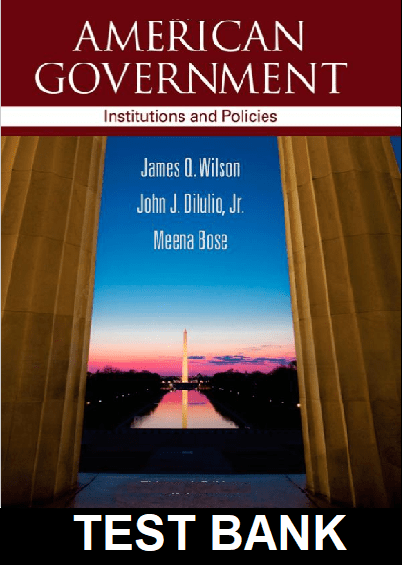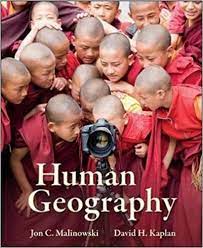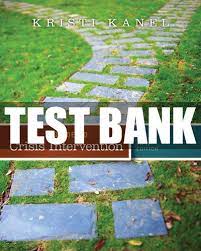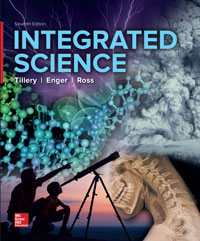Description
Test Bank For American Government Institutions and Policies 13th Edition By Wilson
CHAPTER 3: Federalism MULTIPLE CHOICE
1.In Kelo v. City of New London, the Supreme Court held that the government can seize property
|
a. |
for public use. |
|
b. |
if revenues are short. |
|
c. |
to promote economic development in distressed communities. |
|
d. |
if it has the consent of the community. |
|
e. |
both A and C |
ANS: E REF: 51 NOT: F
2.Most states responded to the Kelo decision by passing laws that
|
a. |
redefined public purpose. |
|
b. |
set up procedures for voting. |
|
c. |
considerably expanded the scope of the government’s power. |
|
d. |
restricted the power of local governments. |
|
e. |
limited the Supreme Court’s ruling to public housing. |
ANS: D REF: 51 NOT: F
3.The concept of separate, sovereign national and state governments is known as
|
a. |
nationalism. |
|
b. |
democracy. |
|
c. |
confederation. |
|
d. |
federalism. |
|
e. |
unicameralism. |
ANS: D REF: 52 NOT: F
4.The text suggests federalism, or federal-state relations, looms behind
|
a. |
civil rights. |
|
b. |
civil liberties. |
|
c. |
the sale and purchasing of liquor. |
|
d. |
the speed limit of certain highways. |
|
e. |
All of the above. |
ANS: E REF: 52 NOT: F
5.For the Founders, federalism was a device to
|
a. |
protect liberty. |
|
b. |
provide efficient local administration. |
|
c. |
encourage citizen participation. |
|
d. |
guarantee equality. |
|
e. |
protect against foreign invasion. |
ANS: A REF: 53 NOT: F
6.Madison’s description of federalism in Federalist No. 46 suggests there should be little concern over conflicts between the federal and state governments because
|
a. |
the federal government would clearly be the winner in such conflicts. |
|
b. |
the state government would clearly be the winner in such conflicts. |
|
c. |
such conflicts would occur only on minor issues of importance. |
|
d. |
they are different agents with different powers. |
|
e. |
the judicial branch would settle such disputes. |
ANS: D REF: 53 NOT: F
7.Which of the following statements about the federal system adopted at the Constitutional Convention is most accurate?
|
a. |
It had been tried without success in other countries. |
|
b. |
It was adopted as an alternative to a confederate system, in which local governments are granted a specially protected existence. |
|
c. |
It granted supreme authority to neither national nor state government. |
|
d. |
It specifically reserved powers not delegated to the United States by the U.S. Constitution to the states. |
|
e. |
It guaranteed the dominance of the states for several hundred years. |
ANS: C REF: 53 NOT: C
8.The Founders did not include in the U.S. Constitution an explicit statement of state powers but added it later in
|
a. |
the Second Amendment. |
|
b. |
the Seventh Amendment. |
|
c. |
the Tenth Amendment. |
|
d. |
the Fourteenth Amendment. |
|
e. |
None of the above. |
ANS: C REF: 53 NOT: F
9.A statement specific to state powers was not part of the original U.S. Constitution because
|
a. |
no such consensus existed at the Constitutional Convention. |
|
b. |
it was deleted under the Virginia Plan. |
|
c. |
New York delegates refused to allow discussion on the matter. |
|
d. |
the U.S. Constitution would not have been ratified. |
|
e. |
it was assumed to be obvious. |
ANS: E REF: 53 NOT: F
10.Just what sort of commerce Congress could regulate between the states was not spelled out in the U.S. Constitution because
|
a. |
no consensus existed. |
|
b. |
of an oversight. |
|
c. |
commerce was a new phenomenon. |
|
d. |
slavery was involved. |
|
e. |
New York delegates refused to allow discussion on the matter. |
ANS: A REF: 53 NOT: F
11.Which statement best summarizes Madison’s view of federalism?
|
a. |
He was a consistent supporter of the notion of a supreme national government. |
|
b. |
He was a consistent supporter of the notion of the supremacy of state governments. |
|
c. |
He was first an ardent supporter of national supremacy, then of states’ rights. |
|
d. |
He was first an ardent supporter of states’ rights, then of national supremacy. |
|
e. |
He assumed the national government would be supreme except in times of war. |
ANS: C REF: 54 NOT: C
12.Applying the principles of Thomas Jefferson to current political issues would probably dispose one to
|
a. |
favor the decentralization of government power. |
|
b. |
oppose the decentralization of government power. |
|
c. |
favor seven-year terms for presidents. |
|
d. |
oppose seven-year terms for presidents. |
|
e. |
favor a more powerful bureaucracy. |
ANS: A REF: 54 NOT: C
13.In Federalist No. 45, Madison describes the powers of state governments as
|
a. |
broad but limited. |
|
b. |
numerous and indefinite. |
|
c. |
narrow but critical. |
|
d. |
limited and subject to review. |
|
e. |
without substance. |
ANS: B REF: 54 NOT: F
14.The Civil War settled one part of the issue of national supremacy versus states’ rights, namely, that
|
a. |
state governments are supreme over the national government. |
|
b. |
the national government derives its sovereignty from the states. |
|
c. |
the national government derives its sovereignty from the people. |
|
d. |
the national government derives its sovereignty from both the people and the states. |
|
e. |
state governments derive their power from each other. |
ANS: C REF: 55 NOT: C
15.The early chief justice whose decisions generally gave the broadest possible sweep to federal powers was
|
a. |
Roger Taney. |
|
b. |
Frederick Vinson. |
|
c. |
John Marshall. |
|
d. |
Alexander Hamilton. |
|
e. |
John Harlan. |
ANS: C REF: 55 NOT: F
16.An important outcome of Marshall’s ruling in McCulloch v. Maryland (1819) was to
|
a. |
place limits on the constitutional powers granted to Congress by refusing McCulloch’s appeal. |
|
b. |
give greater power to the states in taxing agents of the federal government, including banks. |
|
c. |
protect newspaper editors who publish stories critical of the federal government. |
|
d. |
restrict the power of the Court in cases involving conflicts between states and the federal government. |
|
e. |
confirm the supremacy of the federal government in the exercise of the constitutional powers granted to Congress. |
ANS: E REF: 55 NOT: C
17.A central premise in Marshall’s analysis of federalism was that the government of the United States was established by
|
a. |
the convention. |
|
b. |
the states. |
|
c. |
the people. |
|
d. |
the Supreme Court. |
|
e. |
both B and D. |
ANS: C REF: 55 NOT: F
18.The doctrine of nullification refers to
|
a. |
the power of Congress to veto state laws that violate the U.S. Constitution. |
|
b. |
the claimed authority of the states to declare a federal law void for violating the U.S. Constitution. |
|
c. |
the power of the president to veto state laws for violating the U.S. Constitution. |
|
d. |
the authority of the president to dissolve Congress and to call for new elections. |
|
e. |
the power of the federal government to invalidate state laws on matters of commerce. |
ANS: B REF: 56 NOT: F
19.During the battle over slavery, the case for nullification was forcefully presented by
|
a. |
William Jennings Randolph. |
|
b. |
Robert E. Lee. |
|
c. |
William Graham Sumner. |
|
d. |
John C. Calhoun. |
|
e. |
JEB Stuart. |
ANS: D REF: 56 NOT: F
20.The doctrine of dual federalism grew out of a protracted debate on the subject of
|
a. |
commerce. |
|
b. |
banking. |
|
c. |
manufacturing. |
|
d. |
welfare. |
|
e. |
licensing of commercial fishermen. |
ANS: A REF: 56 NOT: F
21.Initially, it was supposed that
|
a. |
Congress could regulate interstate commerce. |
|
b. |
Congress could regulate interstate and intrastate commerce. |
|
c. |
the state governments could regulate interstate commerce. |
|
d. |
the state governments could regulate interstate and intrastate commerce. |
|
e. |
there was no distinction between interstate and intrastate commerce. |
ANS: A REF: 57 NOT: F





Be the first to review “Test Bank For American Government Institutions and Policies 13th Edition By Wilson”